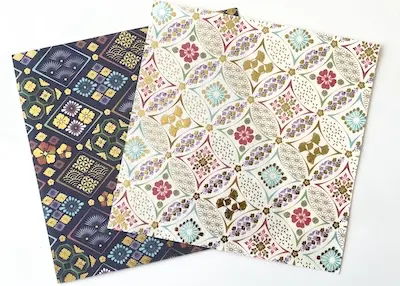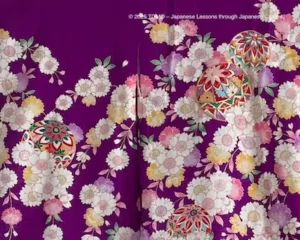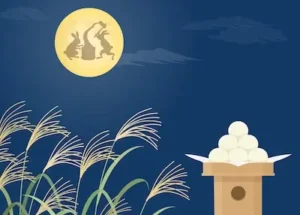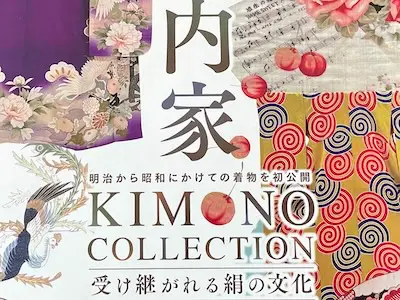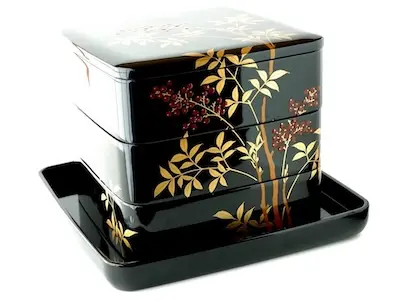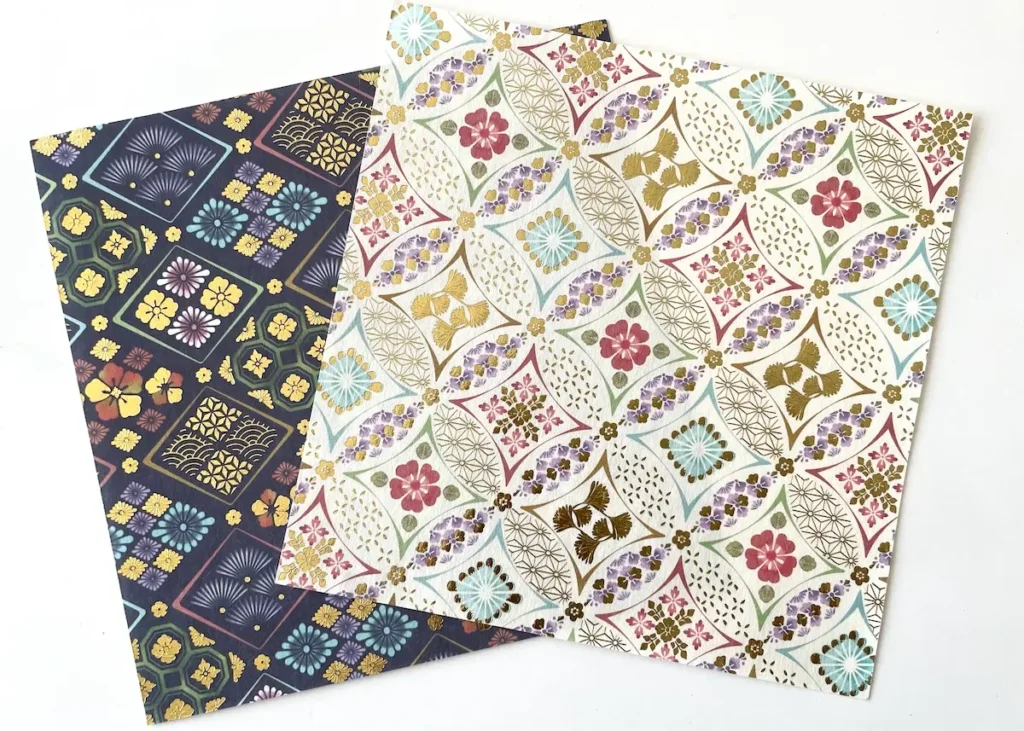
Learn About Origami: Japan’s Traditional Paper Art and Culture
What is Japanese Origami?
Origami is both a traditional Japanese pastime and a form of art.
By folding a single square sheet of paper, you can create many shapes.
These include the paper crane and the samurai helmet.
The paper crane is especially famous as a symbol of peace, and it is recognized all over the world.
Today, washi paper with Japanese patterns and gold designs has also become very popular.
So with just one sheet of origami paper, you can enjoy both tradition and beauty at the same time.
Origami You Can Fold
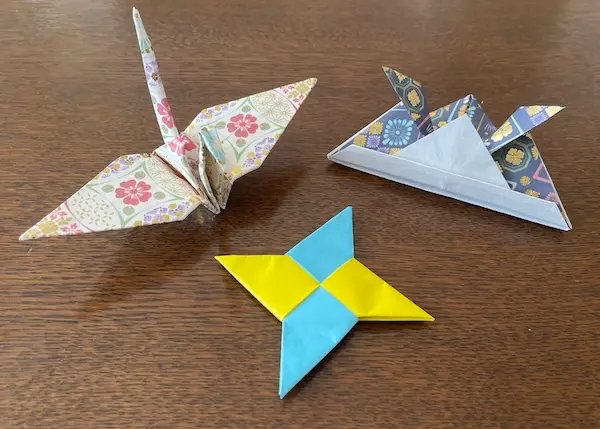
These origami creations—crane (tsuru), samurai helmet (kabuto), and ninja star (shuriken)—were folded by me.
Origami has been enjoyed in Japan for centuries. Many designs reflect Japanese festivals and celebrations.
- 折り鶴 (おりづる, Paper Crane):
A symbol of peace and prayers. It is also famous as the thousand-crane tradition. - 折り紙の兜 (おりがみのかぶと, Samurai Helmet Origami):
Associated with Children’s Day (Tango no Sekku) and wishes for a child’s growth. - 折り紙の手裏剣 (おりがみのしゅりけん, Ninja Star Origami / Shuriken):
Popular as a children’s toy and known as a ninja tool. - 折り紙のかえる (おりがみのかえる, Frog Origami):
A playful design with a jumping mechanism, loved by children. - 折り紙の紙風船 (おりがみのかみふうせん, Paper Balloon Origami):
An old-fashioned toy that you inflate by blowing air. - 折り紙の箱 (おりがみのはこ, Origami Box):
A practical design used to hold small items.
Washi paper with Japanese patterns can be thick and harder to fold.
However, when finished, the results are colorful and show strong Japanese style.
History of Origami
Heian Period and Origata
The origins of origami go back to the Heian Period (平安時代:794–1185).
At that time, it was called Origata (折形, おりがた) and used as a formal way to wrap gifts.
The shape and folding rules had specific meanings, showing manners and social status.
This origata culture later developed into modern origami.
Edo Period Origami Culture
In the Edo Period (江戸時代:1603–1868), paper production increased, making paper more common among ordinary people.
Origami began to be enjoyed as a form of play.
Simple shapes like the paper crane (折り鶴, おりづる), boxes (箱, はこ), and samurai helmets (兜, かぶと) became popular with children and adults alike.
Origami pattern books also appeared, increasing the variety of origami designs.
Meiji Period Education and Origami
During the Meiji Period (明治時代:1868–1912), Western Froebel education (フレーベル教育) was introduced.
Origami became part of children’s education.
It was believed to improve concentration and imagination through hands-on practice.
Thus, origami became essential in schools and at home.
It was valued not only for play items like cranes and shuriken but also for its educational benefits.
Modern Origami and International Spread
Since the 20th century, origami has spread beyond Japan worldwide.
The thousand-crane (千羽鶴, せんばづる) has become a symbol of peace and is often displayed at international events and monuments.
Origami techniques are now applied in mathematics, architecture, and design.
Modern origami also includes cut origami like cherry blossoms (桜, さくら), autumn leaves (紅葉, こうよう), and snowflakes (雪の結晶, ゆきのけっしょう).
These designs represent Japan’s four seasons and are often used in decorations and cards.
Origami continues to evolve from play to art, and even into science.
Conclusion
Origami has developed widely, from traditional folded creations to modern cut designs.
It offers many charms, from classic paper cranes (折り鶴, おりづる) and samurai helmets (兜, かぶと) to playful paper balloons (紙風船, かみふうせん) and ninja stars (手裏剣, しゅりけん).
Using washi paper with Japanese patterns makes the designs even more beautiful and highlights Japanese culture.
Why not try folding your own origami with your favorite patterned washi paper?
Learn about washi (和紙) and Japanese culture here: [Washi (和紙) in Japan: Learn Japanese Words and Culture].
Japanese of the Day / 今日の日本語
- Word:手裏剣 (しゅりけん, shuriken) – Ninja throwing star
- Meaning:A small, sharp star-shaped weapon used by ninjas for throwing.
- Example:折り紙で手裏剣を作ります。
(Origami de shuriken o tsukurimasu.)
I make a shuriken with origami. - Fun Fact:Shuriken were not only used as weapons by ninjas (忍者, ninja).
They were also used to distract enemies or as a signaling tool during missions.
◆ Would you like to talk about Japanese culture? ◆
In the Culture Course, you can learn to speak about Japanese culture with me.
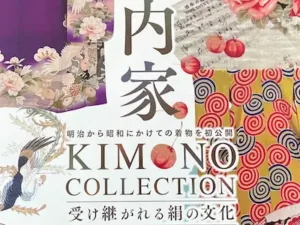
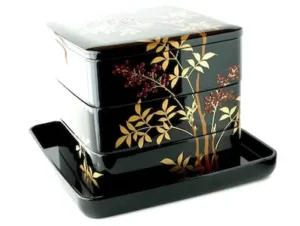
折り紙とは?
折り紙は、日本の伝統文化を代表する遊びであり、芸術でもあります。
1枚の正方形の紙を折ることで、鶴や兜などさまざまな形を作り出すことができます。
特に折り鶴は平和の象徴として世界中で知られています。
最近では、和柄の折り紙や金の模様が入った特別な紙も人気です。
1枚の折り紙で伝統と美しさを同時に楽しむことができます。
折って作る折り紙
日本で昔から親しまれてきた折り紙は、日本の行事や祝い事を反映させているものが多くあります。
- 折り鶴:平和や祈りの象徴。千羽鶴としても有名です。
- 折り紙の兜:端午の節句(こどもの日)で子どもの成長を願う伝統に関係しています。
- 折り紙の手裏剣(忍者の手裏剣):子どもの遊びとして広まり、忍者の道具として知られています。
- 折り紙のかえる:跳ねる仕掛けがあり、遊び心を持つ折り紙として親しまれています。
- 折り紙の紙風船:息を吹き込んでふくらませる、昔ながらの遊びです。
- 折り紙の箱:小物入れとして使える、実用的な折り紙です。
和柄の折り紙は厚くて折りにくいこともありますが、完成すると華やかで、日本らしさを強く感じられる仕上がりになります。
折り紙の歴史
平安時代と折形(おりがた)
折り紙の起源は平安時代にさかのぼります。
当時は「折形(おりがた)」と呼ばれ、贈り物を包むための礼法として使われていました。
紙の形や折り方には決まりがあり、折り方そのものが礼儀や身分を表す意味を持っていました。
この折形の文化が、後の折り紙へとつながっていきます。
江戸時代の折り紙文化
江戸時代になると、紙の生産が増え、庶民の間で紙が身近な存在になります。
この頃から折り紙は「遊び」として楽しまれるようになりました。
折り鶴や箱、兜といったシンプルな形が子どもから大人まで広まり、日本独自の遊戯文化として定着しました。
また、折り紙の図案集や折り方の本も登場し、折り紙の種類が増えていきました。
明治時代の教育と折り紙
明治時代になると、西洋から「フレーベル教育(幼稚園教育)」が導入され、折り紙は子どもの教育に取り入れられました。
手先を使うことで集中力や想像力を育てると考えられ、折り紙は学校や家庭での学習に欠かせない存在となります。
折り鶴や手裏剣といった遊びの要素だけでなく、教育的な価値が認められるようになったのです。
現代の折り紙と国際的な広がり
20世紀以降、折り紙は日本を越えて世界中に広がりました。
特に千羽鶴は平和の象徴として広まり、国際的なイベントや記念碑にも飾られるようになりました。
また、数学や建築、デザインの分野では、折り紙の技術を応用した研究も進んでいます。
現代ではハサミを使って切って作る桜や紅葉、雪の結晶などがあります。
これらは日本の四季を表現できるため、飾りやカードに使われることもあります。
折り紙は「遊び」から「芸術」へ、さらに「科学」へと領域を広げ続けています。
まとめ
折り紙は、紙を折るという伝統的な作品から、切って楽しむ近代的な作品まで幅広く発展してきました。
昔ながらの折り鶴や兜から、遊び心のある紙風船や手裏剣まで、多彩な魅力があります。
そして、和柄の折り紙で作ると、日本文化の美しさが一層引き立ちます。
ぜひお気に入りの和柄の折り紙で、折り紙の世界を楽しんでみてください。
和紙や日本文化についてはこちらをご覧ください。Washi (和紙) in Japan: Learn Japanese Words and Culture

